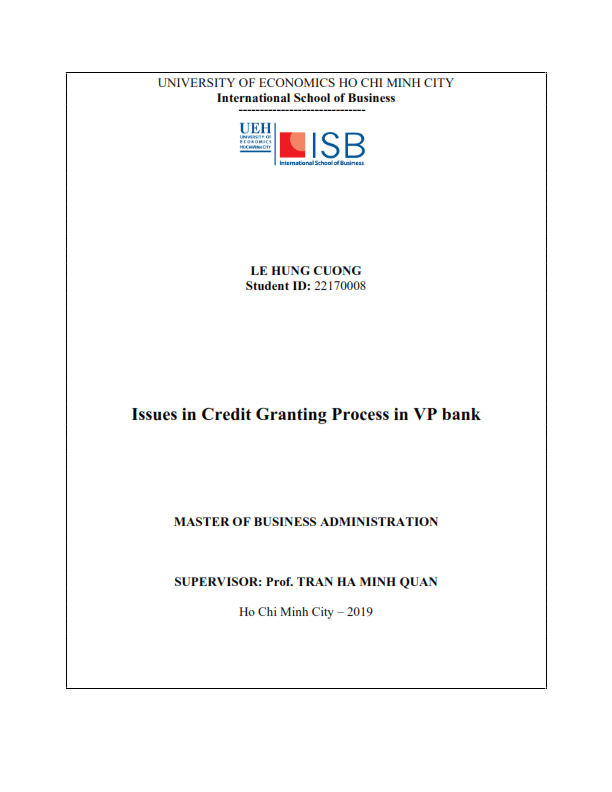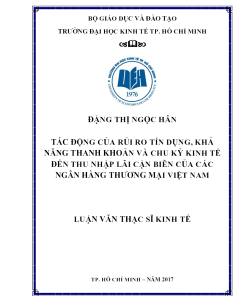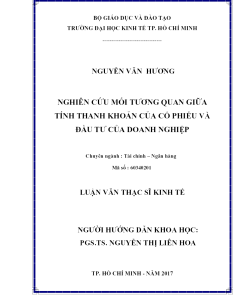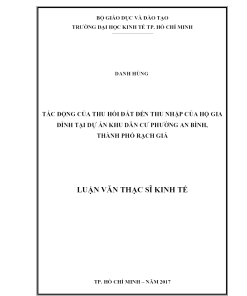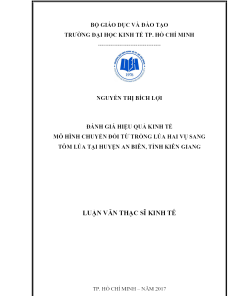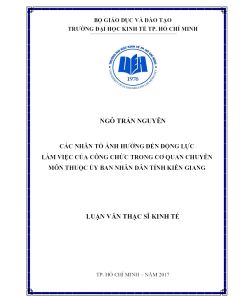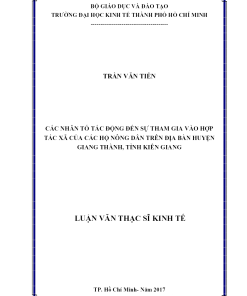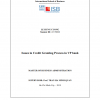Download Master Thesis: Issues in Credit Granting Process in VP bank (ThS08.085)
This research is developed with the objective of identifying the main problems that lead to the downturn of credit growth rate of VP Bank during 2018.
It was captured that VP Bank has faced up with lower credit growth rate in 2018 and this symptom was explained by some problems, namely SBV’s credit growth cap, peer-to-peer lending, overlapped products, lower lending interest rates from bigger banks, higher document processing time, impolite collection activities, slow SMS and mobile internet banking, lack of live banking services, high lead time for customer complaints, incorrect information by sales teams, and less attractive advertising contents.
However, only two problems are actually existed, namely higher document processing time and incorrect information by sales teams. Other problems have not had high impact or have no impact in coming years. Based on that, the researcher proposes set of solutions to help VP Bank to further decrease the time required for document processing and to reduce adverse impact from wrong information provided by sales officers. The set of solutions are translated to change plan with detail solutions, detail actions, people management, and communication.
ThS08.085_Issues in Credit Granting Process in VP bank
EXECUTIVE SUMMARY
This research is developed with the objective of identifying the main problems that lead to the downturn of credit growth rate of VPBank during 2018. It was captured that VPBank has faced up with lower credit growth rate in 2018 and this symptom was explained by some problems, namely SBV’s credit growth cap, peer-to-peer lending, overlapped products, lower lending interest rates from bigger banks, higher document processing time, impolite collection activities, slow SMS and mobile internet banking, lack of live banking services, high lead time for customer complaints, incorrect information by sales teams, and less attractive advertising contents. However, only two problems are actually existed, namely higher document processing time and incorrect information by sales teams. Other problems have not had high impact or have no impact in coming years. Based on that, the researcher proposes set of solutions to help VPBank to further decrease the time required for document processing and to reduce adverse impact from wrong information provided by sales officers. The set of solutions are translated to change plan with detail
solutions, detail actions, people management, and communication.
1
PART I - BACKGROUND
1.1. Company background
1.1.1. History of establishment and development
Vietnam Prosperity Joint Stock Commercial Bank (VPBank) was established in 1993. Over
25 years of doing business in Vietnamese financial and banking industry, the bank achieved outstanding result since its charter capital was reached US$681.49 million and total asset was more than US$12 billion in the financial year of 2018. VPBank has been listed in Ho Chi Minh Stock Exchange (HOSE) with 1.33 billion shares were issued to public investors. VPBank conducted the transformation in 2010, remarked by new logo and brand identify as well as the focus on modern retail banking business under the consultation from McKinsey & Company. In 2011, the bank implemented different business initiatives consulted by McKinsey & Company and successfully raised charter capital to balance with new business capacity and development. In 2012, VPBank achieved national brand value and it established risk management division to monitor risk issues in bank wide level. In 2013, VPBank was rated at B3 by Moody and it conducted Information Technology and Risk Management Master Plan. In 2014 and 2015, VPBank focused on mass consumer market by establishing VPBank Finance Company Limited (FECredit) and the bank was among largest corporate income tax payers in Vietnam. The year of 2016 remarked a big leap since VPBank moved to new head office and total asset was over US$8 billion. The bank also received a loan from International Finance Corporation (IFC) with cheap price. In 2017, VPBank conducted Initial Public Offering (IPO) and it successfully issued 1.33 billion shares and raised nearly US$300 million from public investors. Moody rated VPBank as B2 which was known as an upgrade from the last rating in 2013. Digital banking services have been developed in order meet new business opportunities in the market.
1.1.2. Market share
An illustrative way to capture market share of VPBank is through its market capitalization in comparison with other banks and financial institutions listed in Vietnam stock exchanges. According to the data obtained from cophieu68.com, there are 26 listed banks and financial institutions with total market capitalization of US$39 billion. Currently, VPBank has been ranked
at 6th position with US$2.1 billion, lower than VCB (US$10.8 billion), BIDV (US$5.2 billion),
TCB (US$3.8 billion), CTG (US$3.5 billion) and BVH (US$2.8 billion). Based on this statistics, current market share of VPBank is 5% in term of total market capitalization value.
2
1.1.3. Vision, mission, core values
The vision of VPBank is to become one of the 5 largest joint-stock commercial banks and one of the 3 leading retail joint-stock commercial banks in Vietnam. To support this business vision, the bank conducts two different missions. The first mission is to conduct aggressive organic-growth with high attention to retail, small and medium enterprises (SMEs), consumer finance, and corporate segment. The second mission refers to strong investment and continuous development of foundation systems, including human resource, information technology, risk management, and operation. Moreover, there are 6 core values which are being maintained in VPBank, including make the difference, ambition, customer focus, trust, people development, and productivity. Toward the long-term and sustainable development, VPBank committed to deliver banking products and services to the customers with professionalism, simplicity, dedication, and difference.
1.1.4. Organization structure
Currently, VPBank has been organized by high standardized organization structure. General Shareholder Meetings takes the higher position in the structure and it is being supported by Board of Directors. Chief Executive Officer (CEO) is managing advisory units (finance, risk management, human resource management, strategy and project management) and business units (retail banking, household banking, SME banking, commercial banking, corporate and investment banking, digital banking services, financial institution and transactional banking) and operating and supporting units (credit, operations, information technology, legal and compliance, business intelligence competency center, and marketing and communication). Moreover, current organization structure addresses the importance of different committees, including human resource committee, risk management committee, credit committee, operational risk committee, credit and collections committee. Supervisory board and internal audit are established to support Board of
Directors in entire banking management and monitoring.
3
Figure 1: Organization structure of VPBank
Source: VPBank’s annual reports (2017)
4
1.2. Symptom
During the period of 2014-2018, business performance of VPBank is summarized below:
Table 1: Business performance of VPBank
Indicator Unit 2014 2015 2016 2017 2018
Total asset US$m 7,698 8,826 10,222 12,226 14,028
Equity US$m 423 609 768 1,307 1,508
Saving US$m 5,619 6,925 7,705 8,789 9,524
Lending US$m 3,696 5,317 6,464 8,041 9,476
Lending growth Total operating income
Profit
% 43.86% 21.57% 24.40% 17.85%
US$m 296 549 754 1,102 1,349
before tax US$m 76 141 220 358 399
ROA % 0.99% 1.60% 2.15% 2.93% 2.85%
ROE % 17.92% 23.12% 28.69% 27.38% 26.47%
Source: VPBank’s annual reports (2019)
VPBank’s total asset was nearly double from US$7,698 million in 2014 to US$14,028 million in 2018. Equity was raised from US$423 million to US$1,508 million during the period. The bank attracted depositors with value in 2018 recorded at US$9,524 million while lending value was US$9,476 million. Total operating income in 2018 was stood at US$1,349 million and profit before tax was US$399 million. Although VPBank achieved many remarkable results, the bank faced a shortfall in returns on asset (ROA) and returns on equity (ROE) in 2018. In more detail, ROA of the bank increased from 0.99% in 2014 to 2.93% in 2017 but it dropped to 2.85% in 2018. Similarly, ROE in 2018 was 26.47% lower than ROE in 2017.
The comparison between the target and actual result for the financial year of 2018 provided more detail about the symptom of the bank.
Table 2: 2018 target vs. actual performance of VPBank
Indicator Unit Target Actual Target vs.
Actual
Total asset US$m 15,598 14,028 -10.1% Saving US$m 10,486 9,524 -9.2% Lending US$m 9,943 9,476 -4.7%
Profit before
tax US$m 469 399 -14.8%
Source: VPBank’s annual reports (2019)
5
In March 2018, VPBank delivered a business plan for 2018 in which total asset was expected at US$15,598 million but actual result was captured at US$14,028 million or the actual result is 10.1% lower than the target. Similarly, saving size and loan size were lower than the target of 9.2% and 4.7%. Profit before tax was not achieved the target since it was US$399 million and it was lower than the target by nearly 15%. Lending is key symptom since lending is important item of total asset and the lower lending size affects to total asset. In addition, saving was decreased but it was not the issue since the bank has good funding resources from Internal Finance Corporation. When lending size is decreased, the profit from interest income is decreased. From
2014 to 2018, the structure of net interest income of VPBank is presented below:
Table 3: Structure of net interest income of VPBank
Indicator Unit 2014 2015 2016 2017 2018
Interest income
Interest
US$m 585 854 1,145 1,503 1,748
expenses US$m 335 383 468 595 676
Net
interest income Net interest income
US$m 249 471 678 907 1,072
% growth - 88.92% 43.79% 33.88% 18.11% Source: VPBank’s annual reports (2019)
It was observed that net interest income of VPBank was increased only 18.11% in 2018 compared to 2017 and it was a big drop compared to 33.88% as growth rate of net interest income in 2017. It was captured that the growth rate of net income has been decreasing and the trend has been continuously since 2016. Moreover, lower net interest income is not by high interest expenses. Table above shows that interest expenses in 2018 increased 27.14% and 13.61% in 2017 but interest income increases 31.27% and 16.30%. Therefore, it is concluded that the weaknesses in lending activities is the business symptom in the case study of VPBank. It is translated to the fact that when the bank has lower lending volume, its net interest income will be decreased and it reduces the bank’s profits since large of income source is from lending activities. In the next section, the initial cause-effect map is prepared and it is developed to point out what the main reasons of lower growth rate in lending portfolio of the bank. A focus group of discussion was conducted between the researchers and some branch managers of VPBank and the findings are
categorized into several causes or explanatory factors.
6
1.3. Initial cause-effect map
As mentioned earlier, the interviews with focus group of branch managers helps to capture initial causes that leader to lower lending growth of VPBank during 2018. 5 branch managers were participated into the interviews. To protect the personal information of branch managers, the researcher codes the name of each branch manager as A, B, C, D, and E. For all interviewees, an interview question of what the causes of lower lending size during 2018 was asked and their answers are summarized below.
Branch manager A said that one of the main reason for lower lending size in 2018 was the credit growth rate cap by State Bank of Vietnam (SBV). He mentioned that SBV only allowed local commercial banks to grow their credit at maximum of 14%. However, VPBank was exceeding this level since the third quarter of 2018. He provided the credit growth rate of VPBank was more than 15% after quarter III of 2018 and therefore, the head office team asked him to postpone disbursement activities.
Branch manager B indicated that his branch faced with the shortfall in unsecured lending due to the new peer-to-peer lending activities in the North of Vietnam. He noted that Vietnam has a population of about 96 million, GDP per capita in 2018 is nearly US$2,590 so that Vietnam is considered a potential market for retail banking, and this trend is expected to continue. Moreover, a large number of Vietnamese people have not yet access to banking products and services, and will become a source of retail banking. In particular, in the era of information technology, retail banking activities will be strongly supported when there are millions of new customers from rural to urban areas and having quick access to financial products through the application of new technology. He confirmed that there are new players in Vietnamese financial market with high investment funded from foreign investors in order to provide super convenient unsecured loans to lower income customers. Normally, the third and the last quarter of a year was good time for unsecure lending due to the customers wanted borrowing money to purchase some stuffs (i.e. smartphone, durable goods) but his branch suffered a big drop in customer demand. His sale officers could not achieve the sales target for the third and the fourth quarter because of peer-to- peer lending form. He also noted that peer-to-peer lending platform is faster compared to traditional banking process as the customers can receive the loan in less than 24 hours while the normal disbursement time of VPBank is about 2 days. However, he questioned about the quality
of peer-to-peer lending since it has very high interest rate (i.e. more than 60% per annum).
7
Branch manager C provided the same reason as Branch manager A and B. She noted that her branch could not grow lending portfolio due to SBV’s cap and the raise of peer-to-peer lending has been a threat. Moreover, she emphasized the overlap in product structure of VPBank. Currently, retail banking division provides unsecure lending to individual and household customers. SMEs banking division also provides loan to micro-SME customers which is quite similar to household customers. VPBank has FECredit which is providing unsecured lending to individual customers. She explicated that the bank should review product policy and to combine products from different division into single package. She concerned that the overlapping leads to future business growing issues. She often faced up with the situation of one customer is categorized as household business and retail customers, leading to different loan booking for two segments.
Branch manager D has strong experience in banking and finance. He mentioned that the demand for banking services has been increasing recently, especially retail banking services. Focusing on retailing activities is becoming a trend of commercial banks to diversify revenues, increase business efficiency and reduce operational risks. Only in the period of 2016-2018, the income from retailing activities of banks increased every year with a large growth rate. He indicated that VPBank cannot compete with bigger banks like BIDV, Agribank and Vietcombank in term of interest rate. Generally, the interest rate of VPBank is always higher than BIDV, Agribank, and Vietcombank due to these banks have cheaper sources of funds. He took an example of Agribank since this bank is offering the loan package to lower income customers with interest rate is much cheaper than current 25% as unsecure lending interest rate of VPBank. BIDV and Vietcombank are providing auto loan and home loan with cheaper interest rate compared to VPBank. His concern was further expanding to current operating cost of VPBank was high since the bank has been conducting fast growing business strategy with number of branches and network have been increasing rapidly. The bank did not care about the growth quality for the last few years and it might be the issue in the long run perspectives.
Branch manager E provided another reason for lower lending growth rate. She indicated that document processing time in VPBank was higher than other banks. He noted that TPBank offered loans to the customers in 1.5 days while her branch’s average document processing time is 3-5 days, depending on lending products. A home loan may take more than 1 week to finish and to disburse to the customers. She provided another concern related to collections activities of
VPBank. Some customers went to her branch and claimed for impolite debt collection reminders
8
and they would like to terminate the loans even they were only 1 day of late payment. She mentioned that VPBank may face up with higher loan attrition rate if debt collections activities are not reviewed immediately. She also implicated that foreign banks allow their customers to make a late payment within specific time without impolite reminders.
Based on the interview with 5 branch managers, an initial cause-effect map is prepared and
it is depicted below:
INITIAL CAUSES SYMPTOM
SBV’s credit growth
Peer-to-peer lending
Overlapped products
Lower lending interest rate from bigger banks
Lending growth rate decreased
Higher document processing time
Impolite collections
Figure 2: Initial cause-effect map
Source: Prepared by the research (2019)
The interviews with 5 branch managers help to recognize 6 initial causes of lower lending growth rate in VPBank. These causes are SBV’s credit growth cap, the raise of peer-to-peer lending, overlapped products, lower lending interests from bigger banks, higher document processing time, and impolite collections activities. Among these initial causes, 3 causes are from the market (SBV’s credit growth rate cap, peer-to-peer lending, and lower interest rates from bigger banks) and 3 are from internal business activities of VPBank (overlapped products, higher document processing time, and impolite collections activities). However, the researcher perceives that there are potential other causes for the decline in lending growth rate of VPBank. They are not able to identify through the interviews with branch managers but it can be detected through literature reviews. Therefore, the researcher collected previous empirical evidences about factors affecting lending activities of commercial banks and determine potential causes. Then, these
factors are validated by developing interviews with 5 branch managers in another interview batch.
9
1.4. Updated cause-effect map
Many empirical evidences which were developed by previous researchers highlighted the important factors affecting the decision of the consumers to uptake products and services, including credit, from the banks. Boyd et al. (1994) identified that key factors influencing young customers to select credit services were banks’ characteristics such as location of the banks, reputation level of the banks, convenient of the services, and interest rate. Surprisingly, the customers were less affected by the banks’ employee attitude and the banks’ physical aspects. However, Cicic et al. (2004) obtained contradicted result since the main reason why the customers leaved the bank was the banks’ employees were less courtesy to them. Similar finding was obtained by Maddern et al. (2007). Mokhlis (2009) asserted that the recommendation from reference people was main factor influencing customer decision to select credit services from the banks. Despite Gerrard and Cunningham (2001) highlighted that young customers were less effected by the recommendations from their friends or relatives when they select credit services. Al-Ajmi et al. (2009) identified three factors influencing the choice of credit services from particular bank were religious belief, pricing, and corporate social responsibility. Kamakodi and Khan (2008) developed a questionnaire among 292 banking customers in India and they found some factors affecting to the customer decision to select banking products and services, including the proximity to their workplace, reputation of the banks, friendly banks’ employees, personal attention, ATMs quality, timely services, and pleased services. Coyle (1999) confirmed the role of technologies, speed of services, and effective bank staffs to future banking development. Kazeh and Decker (1993) indicated that the main reason of up taking credit were service charges, reputation, interest charged on loans, quick loan approval and friendly bank staff. Privacy is determined as one of the reason of choosing a bank for credit services and it was highlighted by Haron et al. (1994) and Holstius and Kaynak (1995). Frangos et al. (2012) grouped influent factors to demographic factors, service quality of banking services, the performance and effectiveness of bank policies, and customer satisfaction and perception towards how their benefits were increased by keeping relationship with the banks. After reviewing literatures, the researcher is able to update the causes that possibly
affect to credit growth reduction in VPBank. These factors are summarized in the table below:
10
Table 4: Literatures about factors affecting credit reduction
Sources Factors
Boyd et al. (1994) Location of the banks, reputation level of the banks, convenient of the services, and interest rate
Cicic et al. (2004);
Maddern et al. (2007) The banks’ employees
Mokhlis (2009); Chua
(1981)
Recommendation from reference people
Al-Ajmi et al. (2009) Religious belief, pricing, and corporate social responsibility
Kamakodi and Khan
(2008)
The proximity to their workplace, reputation of the banks, friendly banks’ employees, personal attention, ATMs quality, timely services, and pleased services
Coyle (1999) Technologies, speed of services, and effective bank staffs
Huu and Kar (2000) Suitable interest rates and reduced service charges, speedy service and availability of ATMs
Kazeh and Decker
(1993)
Service charges, reputation, interest charged on loans, quick loan approval and friendly bank staff
Frangos et al. (2012) Demographic factors, service quality of banking services, bank policies, and customer benefits
Source: Prepared by the research (2019)
Table 4 updates the causes leading to lower credit growth of a bank and key factors are technologies (including ATMs quality), bank reputation level, quality of banking services (including bank employee), and location of the banks. These factors are updated in cause-effect
map below:
INITIAL CAUSES
UPDATED CAUSES SYMPTOM
SBV’s credit growth
Technologies
Peer-to-peer lending
Bank location
Overlapped products
Lower lending interest rate from bigger banks
Higher document processing time
Services quality
Bank reputation
Lending growth rate decreased
Impolite collections
Figure 3: Updated cause-effect map
Source: Prepared by the research (2019)
11
Then, the researcher continues to validate how the impact of these factors are visible to credit growth reduction in VPBank and it can be done by conducting interviews with 5 branch managers. Each interview with branch manager was developed in the way of exploring how their opinion towards VPBank’s technology performance, bank location, service quality, and VPBank’s
reputation.
Table 5: Summary of interview for VPBank’s technology performance
Interviewee Summary of interview content
I don’t think VPBank’s technology is weak. In fact, the bank is among top leading technology absorption in Vietnam with the
Branch manager A
Branch manager B
Branch manager C
Branch manager D
Branch manager E
introduction of Timo which is known as the first digital banking
services provider. We deliver internet banking to both retail and
SMEs customers.
VPBank’s technology level is good in overall. The time to access internet banking is fast and responsive user interaction through mobile banking application. It is available in both Android and iOS mobile platform. So, I don’t think there are any issues with VPBank’s technology performance.
Sometimes I got a customer complain about they could not access to
VPBank’s mobile internet banking in specific time. Generally, it was happened during salary pay day and there were often large transactions which were carried out by both salaried customers and VPBank’s employees transferred money to others or paid the bills. Currently, VPBank introduced mobile internet banking services with the integration of many payment services such as electric bill payment, Internet bill payment, television cab, etc. I thought it is
very good services that VPBank is offering to the customers.
However, I believe that other banks also introduce the same services to their customers. The main thing here VPBank has lack of innovative technological based products and services to the customers. For example, I saw that TPBank introduces a service all Live Banking whether the customers are able to take payment cards immediately in this bank’s live counters.
My customers sometimes go to the branch and asked for the issue of they did not receive SMS to know their repayment information. I checked with IT support and found that it was delayed by the system error. I believed that if the bank could not fix this issue, the
customer would not satisfy with VPBank’s service quality. It is my major concern. Other while, I don’t think there are other issues in VPBank’s technologies.
Source: Prepared by the research (2019)
Throughout the discussion with 5 branch managers, it is identified that VPBank does not face many issues related to the bank’s technology performance. Main complaints from the
12
customers were the delayed SMS notification about payment term and slow mobile Internet banking during salary pay date. It is also updated that VPBank does not have innovate Live Banking services like TPBank although Timo was introduced as first digital bank in Vietnam. Therefore, the researcher decides to update technology factor to slow SMS notification and mobile Internet banking and the lack of live banking services.
In term of bank location, the interview with 5 branch managers returned following findings:
Table 6: Summary of interview for VPBank’s location
Interviewee Summary of interview content
I think VPBank does not have good location compared to other
Branch manager A Branch manager B Branch manager C
Branch manager D
Branch manager E
banks like Agribank since Agribank has better network coverage. For instance, my branch has small size and it creates the concern to the customers since it is often full of people to transact.
My branch is located in District 1 of HCMC and the bank network is quite good compared to other banks like Vietinbank or BIDV. I
think branch location is important to almost customers since
Vietnamese people prefer going to the branches rather than doing everything in Internet banking.
VPBank’s branches are not covered well in the district. Only one branch is there to compete with three branches from TPBank. I believe that if VPBank does not open more branch in this district, TPBank will take over my clients soon.
VPBank has more than 200 branches and transaction offices in Vietnam. It is good setup and allows the bank to expand quicker and to approach different customers. However, I faced with the fierce competition from financial companies and they are mostly located in every street to provide finances to individual lower income customers.
I believe that VPBank has good location. I have no concern about
the branch coverage. Current branch can serve well current customer base even we can provide services more to the customers.
Source: Prepared by the research (2019)
The discussion with 5 branch manager in term of VPBank’s location turns out the truth that VPBank has quite good location although there are some concerns to be remarked by the branch managers. The first concern is the location of the bank is not competing well with richer distribution from financial companies. Second, the branch location is not sizeable to fit the demand of more customers. These two issues will be updated to cause-effect map.
In term of service quality, 5 branch managers provided contradicted viewpoint and they are summarized below:
Table 7: Summary of interview for VPBank’s service quality
13




